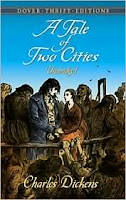---------------------------------------------------------------------------------------------------------------------
Book Review:
---------------------------------------------------------------------------------------------------------------------
Get to Know the Author:
---------------------------------------------------------------------------------------------------------------------
Side Info:
- Who created it? The Oxford Illustrated Dickens
- Who was the author? Charles Dickens
- When was it created? The year of 1859. It was serially in All the Year Round from April 30~November 26 ; Then it was published in to a book by the end of November
- When was it published? This particular book was first published in 1949
- Where was it published? This book was published and printed in the United States by Oxford University Press, USA
- Who is publishing it? It was being published by the Oxford University Press
- Is there anything we know about the author that is pertinent to our evaluation? Charles Dickens didn't complete his story all at once. He had divided the book into 3 parts ( Recalled to Life, The Golden Thread, The Track of a Storm). It was originally a series in All the Year Around. Because of his book being split into three parts, it left cliffhangers that keep the public anxious to want to continue to read; so it was one of few books that had NEVER gone out of print.
- Why does the document exist? A Tale of Two Cities, is considered a "historical novel" that took an historical even and made it into a story. It is telling of (mainly) the French and English Revolution.
- Why did the author create this piece of work? Charles Dickens was steeped in the subject ,especially being swept off his feet by the work of Carlyle's. The horror of the French Revolution has always made an appeal to the imaginative mind.
- Why did the author choose this particular format? Dickens wrote this book in three parts. Though originally it was a series in All the Year Around.
- Who was the intended audience? His intended audience was the public.
- What can we tell of the time period? The time period was during or slightly after the French Revolution.
- What can we tell about the author's perspectives in this piece? Charles Dickens thought this time of history was horrifying, though intriguing at the same time. The French Revolution somehow always makes an appeal to the imaginative mind.
- What was going on in history at the time the piece was created? Charles Dickens lived during the 19th century (7 February 1812 – 9 June 1870). During his time, things weren't going well. His father was in debtor's prison and not long after the rest o the family joined him (except Charles). In order to get his family out, Charles had to work day and night in factories. Things were rough, but eventually he was able to rejoin with his family.
---------------------------------------------------------------------------------------------------------------------
Reflection~
---------------------------------------------------------------------------------------------------------------------
Reflection~
---------------------------------------------------------------------------------------------------------------------
 |
| Original (1859) |
{Quotes}
"It was the best of time, it was the worst of times, it was the age of wisdom, it was the age of foolishness, it was the epoch of belief, it was the epoch of incredulity, it ws the season of Light, it wsa the season of Darkness, it was the spring of hope, it was the winter of despair, we had everythying before us, we had nothing before us, we were all going direct to Heaven, we were all going direct the other way --- in short, ther period was so far like the present period, that some of its noisiest authorities insisted on its being recieved, for good or for eveil, in the superlative degree of comparison only." --- A Tale of Two Cities, Charles Dickens (Opening passage of the book)
" It is a far, far better thing that I do, than I have ever done ; it is a far, far better rest that I go to, than I have ever known."
---A Tale of Two Cities, Charles Dickens
--------------------------------------------------------------------------------------------------------------------- { Read Online }
{ Movie }
Part 1
Part 2
Part 3
Part 4
Part 5
Part 6
Part 7
Part 8
Part 9
Part 10
Part 11
Part 12
Part 13
Part 14
Part 15




Your idea of online reading, and side info is good. Your artifact is very easy to understand and peruse; however, there are still some unfinished parts, and I suggest you to finish them.
ReplyDeleteAnne Wu